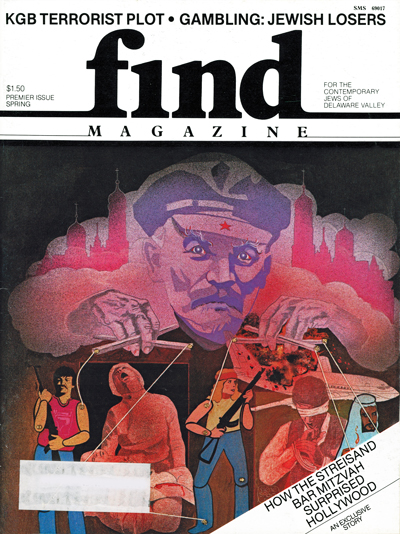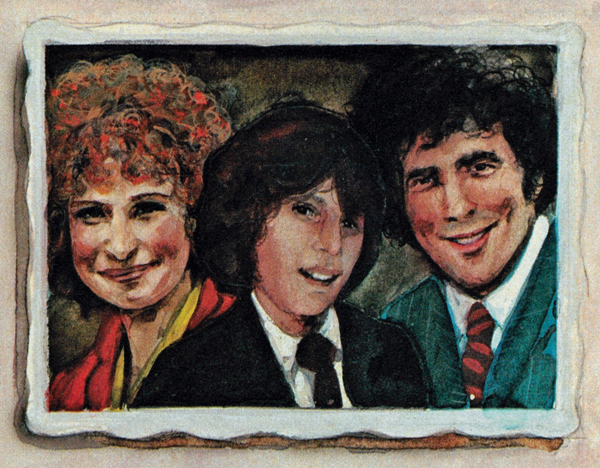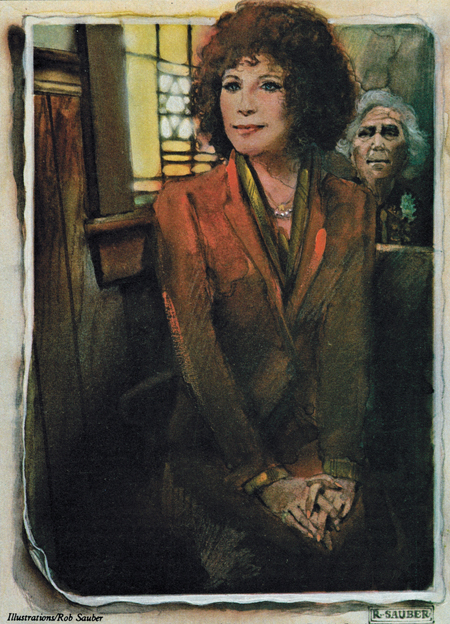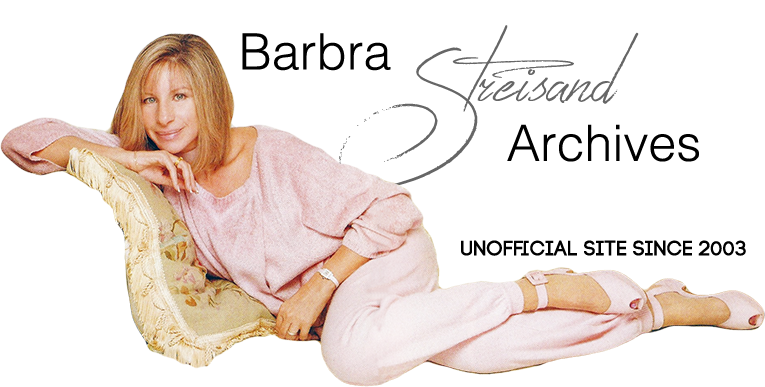STREISAND’S SIMCHA

By Michael Medved
Why Barbra chose a simple ceremony in a small Orthodox shul for her son’s Bar Mitzvah. And the surprising story of the superstar’s reaffirmation of religious faith. A Find exclusive.
Spring 1980; Vol. 1, Number 1
Find Magazine: For the Contemporary Jews of Delaware Valley

Michael Medved is the author of the national best-seller What Really Happened to the Class of ’65 (1976) and the highly-acclaimed The Shadow Presidents (1979). He is the president and co-founder of Pacific Jewish Center in Venice, California.
My shul will never win an architectural award.
It occupies a crumbling, turn-of- the-century building on the oceanfront in Venice, Califomia. Originally the structure housed a bakery and a shoe repair shop, but in the 1940s the proprietors of these two establishments removed the wall that divided them and created a place of worship. Over the years, elderly congregants arranged the interior of the synagogue according to their memories of Eastem Europe. The simple bima is surrounded by four pillars of painted wood. Primitive murals depicting lions, harps and scenes of Israel decorate the walls on every side.
Those murals had been badly damaged during the last decade, but like everything else in the shul, they are in the process of repair. Young volunteers from the congregation’s current membership have replastered the walls to make up for seepage and carefully restored the original murals. Broken windows have been replaced, and the little synagogue—all but abandoned for many years—now boasts a new coat of paint, inside and out. It is still far from elegant, but an unmistakable cheerfulness pervades this place.
One Saturday afternoon in January, a young man of 13 came to the Torah for the first time. Nervously, he recited the traditional Hebrew blessing: “Blessed is the Lord who is blessed . . . who has chosen us from among all peoples and has given us the Torah.”
Behind him, on the left side of the shul, a red-haired woman leaned forward, concentrating her full attention on the boy. The young man stood beside his father and grandfather while the rabbi read four sentences from the Torah scroll. Touching the appropriate spot on the parchment with the fringe of the tallis his father had given him that day, his voice steadied when he pronounced the second blessing: “Blessed are You, Lord God, who has given us the Torah of Truth, and planted everlasting life among us.”
As he uttered the last syllable, cries of “Mazel tov!” arose from the congregation and a shower of hard candy, thrown from every corner of the shul, descended on the boy. Friends and family began clapping their hands, singing enthusiastically: “Simen tov! Mazel tov!”
The young man turned to face them, beaming with relief. He ran down to the women’s side of the synagogue, found the woman in the front row, and kissed her warmly.
Barbra Streisand hugged her son.
The father, Elliott Gould, stood on the bima and smiled.
The Hollywood community has never been celebrated for the fervor of its Jewish commitment. That Jason Gould should have experienced a Bar Mitzvah at all is somewhat surprising. That his parents should have chosen an obscure Orthodox synagogue in Venice—with no pomp, no organ, no choir and no professional cantor—is stranger still.
Why did they select this particular congregation, when no one on either side of the family makes any pretense of traditional observance? The answer to this question requires a brief look at Barbra Streisand’s Jewish identity over the years.

In a sense, that identity has always been exceptionally strong. She climbed to the pinnacle of her profession without changing her name, her nose—or her New York accent. She never attempted to portray herself as anything other than what she is: a gifted, ambitious Jewish girl from Brooklyn.
Barbra’s father, Emanuel Streisand, was by all accounts a deeply religious man. He played a robust and respected role in the secular world around him — but he worked at times as a Hebrew teacher and he put on tefillin in the morning. Barbra’s memories of her father are mostly from family lore. He passed away before her second birthday, but his Jewish influence survived. During her first years of school, his daughter attended an Orthodox parochial institution in Brooklyn, but her memories of that experience reflect the stern and unpleasant atmosphere rather than any substantive Jewish learning. She also went to Jewish summer camps, from which she primarily recalls the delicious yellow cake with chocolate frosting served every shabbat.
From adolescence onward, Streisand enjoyed only the most casual contact with organized Judaism, yet somehow an unfocused hunger for spiritual fulfillment continued to haunt her. At one point, she made a cursory exploration of Eastern religions and even studied yoga for a time. She also recorded a best-selling Christmas album: for her, the carols expressed a general appreciation of the warmth of the holiday rather than a serious interest in Christianity. All the while, she made no attempt to escape identification as a Jew, in public or in private. And she maintained a strong, instinctive pride in her heritage.
Her interest in Jewish history, in fact, led her to buy screen adaptation rights to an Isaac Bashevis Singer short story some 12 years ago. This purchase occurred long before a Nobel Prize helped Singer gain the widespread recognition and popularity he enjoys today.
The story, “Yentl the Yeshiva Boy,” tells of a spirited girl in 19th century Poland who finds her desire for Jewish learning thwarted because of her sex. Driven by a deep inner need for spiritual enrichment, she disguises herself as a young man, enrolls in a yeshiva, and proceeds to fall in love with her leaming partner. A series of dramatic twists and turns brings the tale to a bittersweet resolution.
From the beginning, Barbra found herself fascinated by the story of Yentl. She bought the property against the nearly unanimous advice of business associates and Hollywood experts. Conventional wisdom dictated that no one would pay to see a feature film that told such a bizarre story of religious Jews in long-ago Poland.
Streisand insisted that “Yentl’s” universal themes transcended any single time, place or people. To prove her point, she allowed the story to be adapted as a successful Broadway play, but still film industry resistance to the basic concept refused to disappear.
Strangely, it was “Yentl” who first introduced me to Barbra Streisand.
She had heard through the industry grapevine that I was not only what passes in Hollywood for a “hot young writer,” but that I am also an observant Jew. A meeting was arranged by our respective agents, and that first day we shared six hours of fascinating conversation.
I was astonished by her delicate manners and personal sensitivity—so different from the widely-touted public image —and by her serious Jewish feelings. She, in turn, seemed surprised that a young man of 31, from a non-Orthodox home, who has successfully authored three books and two screenplays, could be so intent on sabbath observances, dietary laws and other aspects of traditional life.
We met half a dozen times after that. We talked about specific details of the “Yentl” proiect—but also discussed a wide range of Jewish questions.
Streisand seemed particularly intrigued by descriptions of my congregation in Venice: a community of committed young Jews which I had helped organize. Since its beginnings two and a half years ago, more than 80 families have moved into our beachfront neighborhood, to rebuild the synagogue, open a full-time day school and launch an ambitious program of adult education. I told Barbra about the community’s growth under the leadership of a remarkable 32-year-old rabbi named Daniel Lapin.
Through a strange coincidence, Barbra’s mother, Dianna Kind, happened to hear about Rabbi Lapin at just the same time I was meeting with her daughter. Mrs. Kind—a vibrant, strong-willed woman in her early 70s—has played an active role in a number of Zionist organizations. And she had recently celebrated her own Bat Mitzvah at a large Reform temple in Beverly Hills. This experience raised her concem, in the manner of Jewish grandmothers everywhere, about the Jewish education of her grandson.
She suggested Rabbi Lapin's name to Barbra as a possible Bar Mitzvah tutor for Jason.
The next time I met with Streisand, we discussed the possibility and decided that the best way to get things moving was to set up a meeting at which she, Jason and Elliott Gould, could talk with the Rabbi and explore available alternatives.
Daniel Lapin—tall, athletic, fair-haired and blue-eyed—is light years away from the conventional stereotype of an Orthodox rabbi. Born in South Africa, educated in Great Britain and Israel, he dresses with formal elegance and speaks with the precise diction of an Oxford don. He is also a licensed pilot, an accomplished skindiver and an ardent sailor, who has taught physics on the college level.
After nearly an hour of conversation — about Judaism, the theory of relativity, reincarnation, marine biology and Beethoven’s fourth piano concerto—Streisand and Gould felt comfortable enough with Rabbi Lapin to air their concerns about Jason's Bar Mitzvah. Must the boy memorize long, dreary pages of Hebrew? Would the ceremony have to be a gala public event? How many months would Jason have to spend in preparation?
Rabbi Lapin reassured them. Jewish law, he explained, requires only three steps for a Bar Mitzvah: that a young man be called to the Torah, that he recite two brief blessings and that he undergo some kind of meaningful education concerning the substance of Judaism. A strictly traditional Bar Mitzvah, in this sense, is actually less arduous than the Goodbye, Columbus productions popular in well-to-do “progressive” congregations. Jason—a sensitive boy with a beautiful, thoughtful face and surprisingly world-weary manner—still remained doubtful about the whole project. But his parents seemed committed to going forward. We suggested that they come to the synagogue for Sabbath services before reaching a final decision.
And there the matter rested.
Two weeks later, I received a call from Streisand’s personal assistant, telling me that Barbra would be visiting our congregation on Friday night.
I had told Barbra that whenever strangers join us for services, they are automatically invited to eat at one of the homes in the neighborhood; informal group meals are very much part of the shabbat routine in Venice. Barbra remembered this point; she, Elliott, Mrs. Kind and Jason planned to accept our offer to join us for dinner after services.
I might as well overcome my embarrassment and make a shameless confession: my wife and I were both thrilled. We felt something like Victorian commoners, suddenly informed that her Majesty the Queen would be arriving for a meal.
At shul that Friday evening, everything went surprisingly well. Streisand and her family took a lively interest in all the details of the service, and members of our congregation accepted the celebrities without awkwardness.
After the Kabbalat Shabbat (“Welcoming the Sabbath”) portion of the service, we followed our usual practice and took a break to watch the sunset. The door to the synagogue opens directly onto the Venice boardwalk, with the sand and sea immediately beyond; we take advantage of this setting to greet the physical reality of the arrival of shabbat.
Our 150 regular worshipers gathered in tight little knots in front of the shul, as they always do, talking over the week just past and the Sabbath ahead; only a few people came over to greet our famous guests.
After this break, we always return to shul for Rabbi Lapin’s Friday evening class, when members of the group take part in a discussion of the week’s Torah portion. After the class, we say Ma’ariv (evening prayers), enjoy our kiddush in the shul — and then, after linking arms to sing “Shalom Aleicheim,” we all walk back to our homes for dinner.
By the time we sat down at the table, Streisand, Gould, Jason and Mrs. Kind all seemed to be falling into the shabbat spirit. They asked questions about the challah, the wine, the relevance of the dietary laws and the songs we sang at the table. Streisand is a good listener; she showed a genuine interest in the other people at the table. She also took particular note of a tiny salt cellar made of green Depression glass that my wife uses on shabbat.
About three weeks after her visit, a package came in the mail with an exact duplicate of the salt cellar; she had found it at an antique shop and sent it off to us immediately with a handwritten note telling us that our original bit of glass ‘Would no longer have to be lonely.”
She displayed the same kind of delicacy and sensitivity after Jason started his weekly Bar Mitzvah lessons with Rabbi Lapin. Streisand felt the entire procedure would be empty and hypocritical unless she pursued her own Jewish education along with her son. The Rabbi enthusiastically agreed. He arranged time for Barbra to study with him for several hours, after Jason finished his regular sessions each week. They reviewed Biblical and Talmudic texts, fine points of Jewish law and the general world view of the Torah. The rabbi was impressed with his new pupil: “She turned out to be one of the brightest and most sincere students I’ve ever taught. She has a natural, almost innate facility for Jewish learning. It’s remarkable how often she comes up with the same questions the Talmud asks concerning a particular passage or idea.”
When word got out that Barbra Streisand spent several hours each week studying with an Orthodox rabbi, Hollywood cynics suggested that she was only looking for free background briefings for her upcoming “Yentl” film. Lapin points out that most of the subjects covered in their discussions bore no possible connection to “Yentl.” Barbra nonetheless felt excited by her exposure to Torah to invite several of her friends to sit in on the informal classes. One of them, songwriter Marilyn Bergman, became a regular participant.
As the day of the Bar Mitzvah approached, Streisand began to show concern that Jason’s private ceremony might turn into a public circus—with curious spectators, members of the press and uninvited guests flocking to our shul and changing the character of an essentially serious occasion. With this worry in mind, the specific date, time and place of the ceremony remained a closely guarded secret. Not even members of our congregation knew which day had been chosen — or that Streisand had scheduled the Bar Mitzvah for the afternoon Mincha services, rather than for the more crowded gathering on shabbes morning.
The group in shul was kept deliberately small, much to the relief of Jason and his parents. Fewer than 50 people attended services, nearly all of them members of the Streisand or Gould families.
The guests stayed on for about an hour after the service ended—chatting and singing over herring and schnapps, cake and fresh-baked challah that my wife Nancy had prepared for the occasion.
The party at Barbra’s Malibu ranch, after the conclusion of shabbat, offered a dramatic contrast to the modest proceedings at shul. More than 200 guests — including James Caan, Neil Diamond and Ray Stark — rode special minibuses from a parking lot near the coast to Streisand’s hideaway in the hills. There, three art deco tents provided room for drinking, eating and disco dancing.
As a concession to California convention and to several of their close friends who insisted that no Bar Mitzvah could be complete without it, Streisand and Gould arranged for a “candle-lighting ceremony” in the midst of their celebration. As part of this ritual, relatives and friends trouped up to kindle individual lights on a 13-branched candelabra. Jason suffered the procedure with thinly-disguised contempt; the only thing that made the whole rite endurable was the wacky good humor of Elliott Gould, who served as emcee. Gould, who co-hosted the entire party with his ex-wife, presided over the candlelighting in the best tradition of standup burlesque comedy.
We overheard a few guests behind us talking about the candle-lighting with respectful amusement: “Yeah, well, they had to do it. It’s a Jewish tradition, you know.”
One genuine tradition fared considerably better: Streisand took the trouble to provide a full table of strictly kosher food, as an alternative to the gourmet Chinese buffet offered to most of the guests. To make sure that the rabbi and Mrs. Lapin, Nancy and I would feel entirely comfortable with the kashrut, Barbra even bought a new set of glass dishes for the occasion.
A highlight of the evening involved a curious blend of Hollywood and Eastern Europe. Barbra’s mother decided to use her grandson’s Bar Mitzvah party to stage her own debut as a singer. She walked to the front of the tent and entertained the wildly cheering crowd with a heartfelt rendition of the Yiddish melody, Oif'n Pripechik. The English words sounded florid and awkward, but no one noticed, in the fervor of Mrs. Kind’s singing. She hit the high notes with a thrilling clarity reminiscent of her daughter’s celebrated tones.
Before the end of the party, Streisand circulated through the crowd to greet each guest personally. When she arrived at our table, she thanked Rabbi Lapin warmly. And then she turned to me.
“You know,” she said, “that Jason is something else. Know what he told me? He said, ‘This party tonight, this is Hollywood. But in shul today: that was for real. It was really OK!’”
In the days following the celebration, Barbra made it clear that she also is for real. She is, for one thing, continuing her studies with Rabbi Lapin. At the same time, she maintains her interest and involvement with the Venice community. Our new Jewish day school, which opened its doors last September, has especially benefited from her support. That school, with 44 full-time students, is based on the concept that children must be drawn to traditional observance through the warmth and vitality of the institution and its teachers, rather than pushed by hard-and-fast rules enforced by stern authority figures.
In view of Streisand’s backing — amounting to nearly 20 percent of the school’s budget this year and including a long-term commitment through 1984—the institution will be renamed in honor of her late father, Emanuel Streisand. Of- ficial rededication of the school will take place at the beginning of the next academic year.
In the same generous spirit, Elliott Gould has gone out of his way to support the school and the community. Along with his wife Jenny and his children, Sam and Molly, he has become a frequent guest at Rabbi Lapin’s table, and a well-liked and accepted participant in a variety of community activities.
And so . . .
What should we make of all this?
It would be easy enough to dimiss this entire series of relationships as an example of mutual manipulation—of Hollywood stars and Orthodox activists using one another for purely selfish reasons. I have already heard some snickers from resentful quarters in the larger community concerning Streisand’s connection with our congregation. This argument maintains that she chose the Venice shul because she wanted to see her son Bar Mitzvahed as quietly and painlessly as possible. According to this logic, the shabby little shul on the ocean front might even be considered quaint or chic, and might even serve as a bizarre conversation piece for La Streisand and her elegant friends.
This worst-case interpretation fails to account for several factors. It does not explain Streisand’s intense personal commitment to a program of Jewish learning; no one ever demanded that she pursue her own studies in Torah during the period of Jason’s Bar Mitzvah instruction. The cynics will also have a tough time explaining her renewed determination to make a film of Singer’s “Yentl.” As it happens, her association with Venice comes at a time when she is taking an unprecedented professional risk to produce a movie of genuine Jewish content—a subject she has lovingly chosen for her first directorial vehicle. Nor does Ms. Streisand’s heavy and continuing involvement with our day school square with the notion that her recent Jewish explorations are only a passing fancy.
The facts of the situation permit only one conclusion: Barbra Streisand’s recently rekindled interest in traditional Judaism is absolutely sincere. Anyone who discusses the subject with her for as much as five minutes will see her passion and her hunger. This is not to suggest that Ms. Streisand is now on her way to becoming Orthodox—far from it. But the truth remains that her contact with Jewish learning has come to play an increasingly important part in her life. In this, she reflects a general need for traditional roots and spiritual nourishment that is sweeping among many American Jews. Streisand is certainly not alone in finding that need most satisfactorily filled by a style of Judaism pure and authentic.
In considering the personal growth of this fascinating woman, I am reminded of a haunting story she told me about her childhood. As a little girl, she had a friend whose parents were left-wing intellectuals and, in the enlightened fashion of the times, self-proclaimed atheists. At age six, she and this friend used to engage in lengthy discussions about the existence of God, with Barbra’s companion insisting self-righteously that the whole notion was ridiculous. One afternoon just before dark, they sat together on a Brooklyn fire escape watching the street traffic below, as the argument became particularly heated. Barbra came to the verge of tears, trying desperately to convince her friend of the existence of a deity. “I know He’s there. I know it,” she pleaded, and pointed to a gentleman in an overcoat on the pavement below. “I’ll prove to you that God is real. He’ll prove it to you. Because right now—just at this moment—that man down there is going to turn at the corner and cross the street.”
To the absolute astonishment of Barbra and her friend, the gentleman in question did precisely that.
“I’ve never forgotten that afternoon,” says Barbra Streisand. “And the last couple of years it keeps coming back to me. I’ve always had this kind of special relationship with whatever it is that’s out there.”
That special relationship continues. And Barbra herself has decided to cross the street.
END.
[Barbra Archives Note: Michael Medved has been extremely critical of Streisand since his change from liberal activist to outspoken conservative, especially in his 2004 book Right Turns: Unconventional Lessons from a Controversial Life. Even Rabbi Lapin—an Orthodox Jew—has written several damning articles about Streisand, despite their apparent good interactions described in this article from 1980.]
